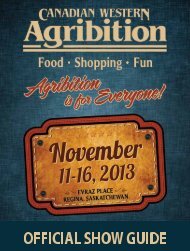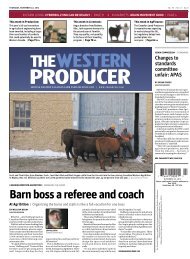Create successful ePaper yourself
Turn your PDF publications into a flip-book with our unique Google optimized e-Paper software.
CANADIAN WESTERN AGRIBITION | INTERNATIONAL BUYERS<br />
NEWS<br />
BY MICHAEL RAINE<br />
SASKATOON NEWSROOM<br />
THE WESTERN PRODUCER | WWW.PRODUCER.COM | DECEMBER 13, 2012<br />
Foreign cattle producers look to Canada for genetics<br />
Erling Gresseth of Veistad Charolais in Hegra, Norway, bought 70 embryos and a two-thirds share of a bull for semen<br />
production during the <strong>Western</strong> Canadian Agribition in Regina. | MICHAEL RAINE PHOTO<br />
REGINA — Erling Gresseth makes<br />
the trip to Canadian <strong>Western</strong> Agribition<br />
in Regina because he can<br />
count on the show delivering profitable<br />
results for his purebred cattle<br />
business in Norway.<br />
Gresseth bought 70 Charolais embryos<br />
at this year’s show as well as an<br />
interest in semen rights from a bull<br />
owned by Bryan Hicks of Arthur, Ont.<br />
He will also be taking back 20 to 30<br />
embryos for producers in Sweden.<br />
“I need to be able to place a lot of<br />
trust in the people I buy from (when)<br />
overseas. My business depends on it,”<br />
<strong>The</strong> smile says everything.<br />
InVigor ® growers are just like any other grower. <strong>The</strong>y<br />
believe in community, they love their families, and they<br />
work hard to ensure there’s food on everyone’s table.<br />
<strong>The</strong> big difference is how InVigor growers feel about<br />
their crop. But since they have trouble putting it into<br />
words, you’ll have to take it at face value.<br />
Nothing outperforms InVigor.<br />
O-66-10/12-BCS12259-E<br />
37<br />
said the purebred breeder from<br />
Hegra, Norway.<br />
Gresseth has been buying Canadian<br />
Charolais genetics since 2007 but<br />
said he wouldn’t do it if he didn’t<br />
have a personal relationship with<br />
producers here.<br />
“I need to see the herd and get a<br />
sense of it, and know the people I am<br />
dealing with. I won’t make any profit<br />
on the genetics I buy here for four or<br />
five years. I put a lot of trust in these<br />
people and in their cattle.”<br />
Häkon Kvaeken of Löten, Norway,<br />
was also at the Regina show, one of<br />
700 to 800 foreign visitors from 60<br />
countries. He said the need for polled<br />
genetics is prompting buyers from<br />
Europe to look to Canada rather than<br />
to the home of the breed.<br />
“<strong>The</strong> French cattle don’t really have<br />
the polled (genes),” he said.<br />
“We can’t rely on it, and we don’t<br />
want to be dealing with horns.”<br />
Gresseth bought a purebred bull in<br />
the United States last year and found<br />
it was easier to bring the semen to<br />
Canada to fertilize eggs before shipping<br />
them to Norway.<br />
“I rely on the help of cattle marketing<br />
people like Helga and Candace<br />
(By) from Regina to make sure what I<br />
buy gets to Norway without any<br />
issues,” he said.<br />
“Canadian breeders are very experienced<br />
at exporting. It might be a<br />
bigger part of their business than in<br />
some other places in the world.”<br />
Gresseth said his customers are<br />
looking for polled genetics and<br />
smaller, thriftier animals that are<br />
feed efficient.<br />
“Our feed costs are way high, and the<br />
cattle need to be good in the trees, in<br />
rough country. We have a long days on<br />
grass in the summer. Winter can be<br />
very hard,” he said about his location,<br />
half way up the Norwegian coast.<br />
Kvaeken said many of the non-traditionally<br />
coloured cattle won’t make<br />
the breed standard in Europe, so dark<br />
Charolais or black Limousin found in<br />
North American herds aren’t on the<br />
Scandinavians’ order books.<br />
He also said many of the North<br />
American breeds have come to look<br />
alike. North American cattle have<br />
been bred to what appears to be a<br />
single standard, he said.<br />
“We like them, but they don’t have a<br />
lot of difference between them,<br />
except the colour.”<br />
Gresseth said the shorter stature<br />
and more muscular hip in the Canadian<br />
continental breeds meet his<br />
customers’ breeding needs. However,<br />
he has tended toward a more traditional<br />
Charolais shaped animal for<br />
his Canadian imports.<br />
“(Hicks) kept the deep body, with<br />
the larger muscle that buyers look for.<br />
That is traditional Charolais,” he said.<br />
Hicks said he is proud that his<br />
Charolais genetics are being used in<br />
Europe.<br />
“It would be easier for them to get<br />
(traditional) French animals, but<br />
many European buyers want what<br />
we have to offer instead,” he said,<br />
during the Nov. 19-24 event.<br />
Gresseth said producers in northern<br />
Europe are doing well financially,<br />
despite small farm sizes.<br />
“Meat is very highly priced. <strong>The</strong><br />
(governmental support) system<br />
ensures they make a living and deliver<br />
food at a profit. So very good farmers<br />
do very well. And they invest in<br />
their herds’ (genetics),” he said.<br />
“<strong>The</strong>y buy Canada’s reputation, too.”








